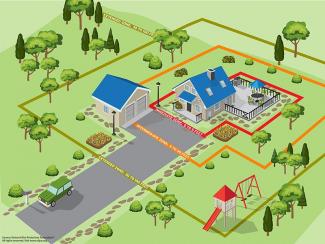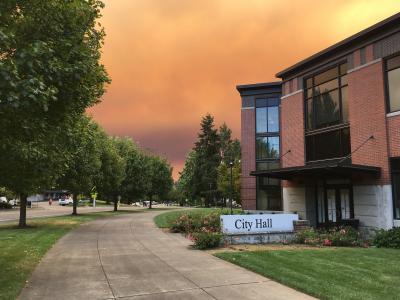Extreme Heat & Wildfires
The 2020 wildfire season was one of the most devastating in Oregon’s history, burning roughly 1.2 million acres and destroying more than 5,000 homes state-wide.
In Clackamas County, the Riverside Incident (138,054 acres, 139 structures lost and 4 injuries) and the Clackamas Fire Complex (11,210 acres) fires left a lasting impact close to home, and served to remind us of the importance of being prepared when wildfires threaten our region again.
Building Defensible Spaces
 One of most critical steps you can take is to create a defensible space around your home by reducing or removing flammable materials near your home. Remove pine needles, dry leaves and other highly-flammable materials. Trim branches that hang over your home, and remove any leaves, needles, and sticks from your roof and gutters. Also, keep wood piles and propane tanks at least 30 feet from homes.
One of most critical steps you can take is to create a defensible space around your home by reducing or removing flammable materials near your home. Remove pine needles, dry leaves and other highly-flammable materials. Trim branches that hang over your home, and remove any leaves, needles, and sticks from your roof and gutters. Also, keep wood piles and propane tanks at least 30 feet from homes.
Use this checklist from our partners at Clackamas County Disaster Management to complete several preventative steps to prepare your home for wildfire season.
Sign Up to Receive Alerts
Visit PublicAlerts.org to sign up to receive emergency notifications, including evacuation warnings, by text or email. You can select geographic locations and the types of alerts you’d like to receive. If conditions warrant an evacuation, local law enforcement and fire districts will coordinate with Public Alerts to define the affected areas and send notice.
- Sign up now (Clackamas County)
- Sign up now (Washington County)
Pro tip: If you live, work, and play in multiple counties, sign up in each county's system.
Tracking Evacuation Alerts in Real Time
Our partners at Clackamas County Disaster Management maintain an interactive web map that allows residents to track fire locations and current evacuation status in real time.
buy fire-resilient plants
Fire-resilient plants don’t ignite easily. They can be damaged or ruined by fire, but their foliage and stems do not significantly add to a fire’s intensity. Generally, these plants have moist, supple leaves and no dead wood or materials within the plant. They also have low or water-like sap without a strong smell. Deciduous trees like oaks and maple trees, which lose their leaves at the end of their growing season, are examples of fire-resilient plants. Annuals and lawns can also be fire-resistant if properly watered and maintained. Oregon State University Extension Service offers resources on creating landscape and plants that are fire-resistant. So do most local nurseries.
Avoid planting (and/or remove) any highly flammable plants directly around your home. These can generally be identified by fine, dry, dead leaves or needles. They typically have gummy, resinous sap and their leaves, stems, and twigs contain oils and wax that can catch fire. Their sap and leaves have a strong smell. Juniper is an example of a highly-flammable plant commonly found in landscaping.
Understanding Oregon's "Ready, Set, Go" Evacuation Status Levels
 Oregon’s “Ready, Set, Go” evacuation system defines three warning levels to help people prepare in the event evacuation becomes necessary:
Oregon’s “Ready, Set, Go” evacuation system defines three warning levels to help people prepare in the event evacuation becomes necessary:
- Level 1: BE READY. Evacuation may become necessary. Be aware of the danger and monitor emergency services websites and local media outlets. Consider precautionary evacuation of people with special needs, mobile property, pets or livestock.
- Level 2: BE SET to evacuate. Evacuation may be required at a moment’s notice; there is significant danger in your area. Consider voluntarily relocating to a shelter or with family and friends outside of the affected area. If choosing to remain, to be ready to leave instantly. Gather necessary items at your own risk. If conditions rapidly deteriorate, you may not receive further notice.
- Level 3: GO! Evacuate now! Leave immediately! Danger is imminent, and emergency services may not be available to assist you further. DO NOT delay leaving to gather any belongings or make efforts to protect your home.
You can print these orders in several languages at Clackamas County's website, including English and Spanish.





